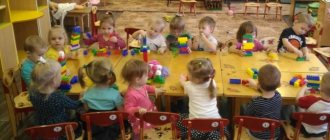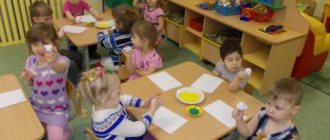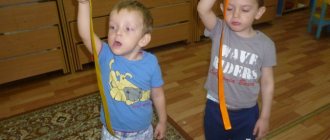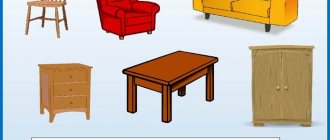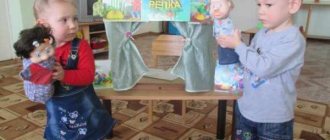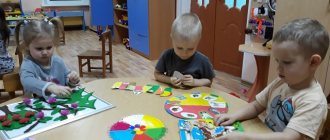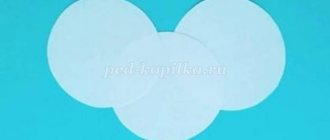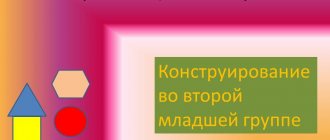GCD for the construction and development of speech in the 2nd junior group of preschool educational institutions
GCD for the design and development of speech “An old fairy tale in a new way”
Author’s development for the design and development of speech “An old fairy tale in a new way”, this development can be useful for kindergarten teachers and parents, you can play these games with children on a walk, you can complicate them. Integration : cognition, communication, construction, work, music. Goal: To introduce children to the art of paper design. Objectives : Teach new techniques for working with paper; Introduce children to the properties of paper and a new technique for constructing toys from crumpled paper; Develop the ability to follow oral instructions. Develop children's speech and fine motor skills. Reinforce the rules of cultural hygiene skills. Cultivate compassion for forest animals in difficult situations. Activation of the dictionary: the paper is white, thin, smooth, rustling; forest dwellers. Material : House, figurines of fairy tale characters, chest; A4 paper, audio recordings by E. and S. Zheleznov “Bunny”, “Lullaby”, “Fox - SA, sy, su”, puppet theater “Kolobok” Preliminary work with students: Repetition of the fairy tale “Kolobok”, conversation about appearance, habits, habitat and lifestyle of wild animals: hare, wolf, bear, fox; repetition of paper properties (thin, smooth). Introductory part. Educator : Guys, do you like fairy tales? Children: Yes! Educator: Let's see who lives in our fairy-tale house? (The children look into the house and see their grandparents there (puppet theater)) I suggest sitting on the chairs and listening to the fairy tale they brought. Educator: “Once upon a time there lived grandfather and grandmother. And then one day the grandfather said to the grandmother: “Many guests will come to us today, so bake some koloboks for a treat.” And the grandmother answers: “What to bake from, we don’t have flour!” “And you mark the barn, scrape the bottom of the barrel, and you’ll get it.” Grandma did just that. Educator: Look, this chest. I took it with me. Do you want to see how much flour there is? Children: Yes, we want! (The children look into the chest and want to find out how much flour there is, but instead of flour they find paper.) The main part. Educator: Guys, do you think we can make koloboks from this for our guests? (Children's answers). After answering, I invite the children to sit down. Children begin to examine and examine the paper (white, smooth, thin) Educator : Let’s try to make koloboks out of paper. For this we need clean hands. We talk through the rules of hand washing and wash our hands according to the rules. Educator: Let's roll up our sleeves, open the water tap, take soap, wash our hands with soap, put the soap in the soap dish, wash our hands under some water, wash our hands, wash each finger, shake off the remaining water in the sink, close the tap and dry with a towel. Now you can get to work. Educator: First, we’ll take all our paper flour and move it up a hill, can you hear how the paper rustles? Now we will carefully unfold our paper dough. Handle it carefully because the paper may tear. And now we will again crumple our paper dough into a lump so that we get koloboks. (Children crumple the paper into balls) Show me what you got? You made such wonderful buns! The guys in the fairy tale, the kolobok sang songs, and your koloboks will be able to sing, Why, what are your koloboks missing? Children: children's answers Educator : Of course your buns lack a face! I distribute ready-made faces to each child. Educator: Place the face on it and spread it with glue, then attach your wad of paper to the face and press it firmly with your palm. The children do the work. Educator: Well, now everything is in order! Be careful, don't get burned! Let it cool! Children, what happened next to Kolobok? Children's answers. A magpie bird (toy) flies into the group and shouts: Kar, kar, quickly help, there is trouble in the forest, forest animals are in trouble! Kar, kar! Flies away. Educator : Guys, there’s trouble in the forest, what should we do? Children's answers. Educator: Well done! Aren’t you afraid to go into the forest, because the road is difficult and long? Children's answers. Physical exercise Animal exercises One jump, two squats. – squat jump. This is a rabbit exercise. And when the foxes wake up, we’ll open our eyes and stretch. They like to stretch for a long time. And the wolf cubs arch their backs. – bend over and jump slightly. - jump. Well, the bear is clubfooted, with its paws spread wide. First one, then both together. - We step from foot to foot. He has been marking time for a long time. And for those who don’t have enough exercise, let’s start all over again. We spread our arms to the sides. Educator: So we got to the edge of the forest! A bunny is sitting at the edge of the forest and his leg was crushed by a log. Educator: Guys, look who it is? Children: bunny Teacher: turning to the bunny: What happened to you? Bunny: There was a strong wind in the forest and one branch was torn from the tree and my leg was crushed and I can’t move it! Educator: Guys, what should we do? The children put the stick away. The bunny thanks the children and invites them to play a game with him. I turn on the audio recording “Bunny” Educator : Did you like playing the game? It's time for the bunny to go to his cubs, what are the names of the bunny's cubs? Children's answers. Say goodbye to the hare. We go further, we meet a wolf, the wolf howls ooooh. A wolf is sitting and there are a lot of clothespins on the fur. Educator : Who is this? Children's answers. Educator: What happened to you? Wolf: I fell into a hole and stuck thorns on my fur and I can’t remove them ooooh. Educator: Guys, how to help the wolf? Children unfasten clothespins. The wolf thanks the children. Educator: Well done guys, now the wolf is free and it’s time for him to go to his cubs, what are the names of the wolf cubs? Children's answers. We say goodbye to the wolf and move on. On the way to the bear's den, the mother bear is sleeping, and the cubs (according to the number of children) are sitting and crying. Educator: Guys, someone is crying, who is it? Children's answers. Educator : What happened? Bear cubs: Winter is coming, it’s fallen asleep, but we can’t sleep. Educator: Guys, how can we help the bear cubs? Children's answers. Educator: (if the children don’t tell me, I’ll lead you to sing a lullaby and rock them) I turn on an audio recording of a lullaby. The cubs fall asleep, the children and I lay them down next to their mother and quietly move on. Educator: And here’s someone else, who is it? Children's answers. Educator on behalf of the fox : Guys, I wanted to eat a bun and burned my tongue and now it hurts! Educator : Guys, blow on the fox's tongue! Now let’s teach you how to do tongue exercises! And you little fox, listen and remember! I turn on the audio recording, the children repeat the syllables and words. Educator: Well done guys, did you like the fox exercise? Educator on behalf of the fox : What a fun exercise and your tongue doesn’t hurt anymore, thanks guys! Educator: Guys, the fox told me in my ear that she won’t eat the kolobok anymore, but wants to be friends with him! We say goodbye to the fox and return for . The children are greeted by their grandfather and grandmother. Educator on behalf of grandfather : Grandma, the guys are back! Well, tell grandma and I what happened in the forest? Children's answers. Educator on behalf of the grandmother : Tell your grandmother how you liked rescuing the animals? What's the most? Q: How are our koloboks cooled down? D: Yes. Q: It's time to treat our guests! Children hand out their bun to the guests if they wish. Dear guests, did you like our koloboks? Guests evaluate children's work
We recommend watching:
Summary of GCD for children of the 2nd junior group on the topic: Winter Summary of GCD cognition using ICT in the 2nd junior group. Journey to the autumn forest Notes of GCD in the 2nd junior group: Wild animals Notes of GCD on speech development in the second junior group topic: Vegetables
Similar articles:
Summary of lessons in kindergarten in the 2nd junior group. Group room
Summary of lessons in kindergarten in the 2nd junior group. My family
Summary of a lesson in the junior group of kindergarten on the topic: “Human nutrition”
Lesson notes about kindergarten. Junior group
